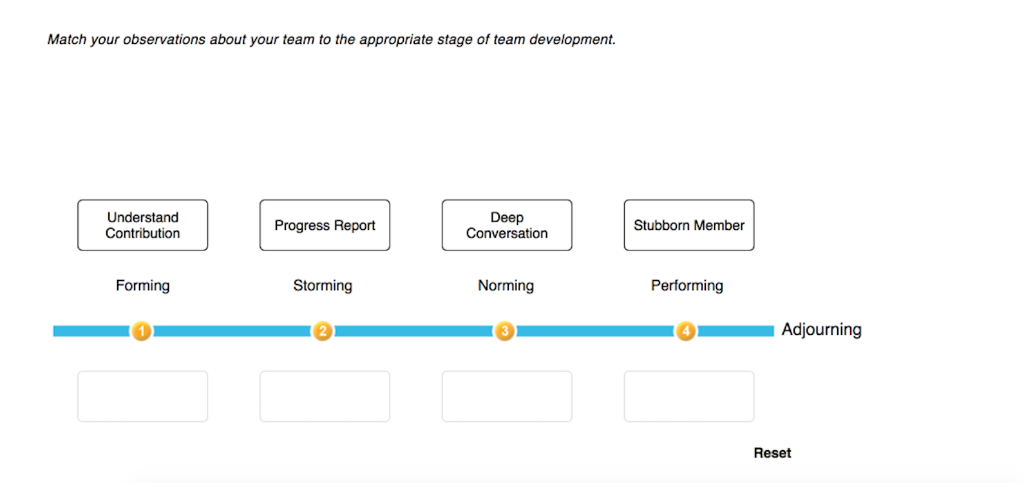Team Development Happens In 5 Phases

When you understand it, you possibly can assist your new team become effective extra quickly. Finally, the project is coming to an finish and members are shifting into different roles and obligations. This stage appears https://globalcloudteam.com/four-stages-of-team-development-what-you-need-to-know/ at the group from the perspective of the nicely-being of the team rather than from the attitude of managing a team through the original 4 levels of team improvement.
Top 10 – Project Management Apps
Tuckman’s Forming, Storming, Norming, and Performing model describes these phases. When you understand it, you can assist your new staff become efficient and extra shortly. In the following article, we’ll look at how you need to use this similar mannequin to build a extremely productive team.
Stage #5 — The Adjourning Stage
One of probably the most well-known – and perhaps probably the most intuitive – is known as the ‘forming, storming, norming and performing’ mannequin of staff development. In this stage, members of the design staff establish the models and processes for management, instructing, learning, and administration that might be used once the college is running. The design team may even https://globalcloudteam.com/ develop the college proposal and secure autonomy agreements. The Storming stage is the most intense of all of the phases, with numerous steps and design issues.Design group develops further, following roles and processes established within the Forming stage. The team also creates roles and processes for the school management group that can run the school in the Norming, Performing, and Transforming levels.
Perhaps one of the best-identified scheme for a gaggle growth was advanced by Bruce Tuckman in 1965. Initially, Tuckman identified https://www.luxoft.com/ four stages of group improvement, which included the stages of forming, storming, norming and performing.
What happens in the storming stage?
The stage we focused on was the norming stage of group development, which is the stage that involves bonding and the development of a group identity. During this stage, the group may even develop a sense of synergy, which means that the members feel they can accomplish more together than they could on their own.
This simple however efficient mannequin is usually used today to help leaders who are working to build a cohesive, excessive-efficiency team. In 1965, psychologist Bruce Tuckman published his stages of staff growth – Forming, Storming, Norming, and Performing – in an article known as “Developmental Sequence in Small Groups”. A few years later, he completed the list stages of team development with ‘Adjourning’. These phases explain why it takes time and persistence for a staff to achieve peak productiveness. Team formation takes time, and groups often undergo recognizable stages as they change from being collections of strangers to becoming united groups with widespread goals.
It is important to notice that steady work groups may revert to prior levels when new individuals are added to the staff. Most specialists in staff development agree that teams will undergo 5 completely different stages. How quick a staff moves through every stage will depend on the team members, their particular person expertise, the work they’re https://ru.wikipedia.org/wiki/EPAM_Systems expected to do, and the kind of leadership out there to the staff. The mostly used framework for determining levels of team improvement was launched by Bruce Tuckman in the 1960’s. His 4 stages and descriptions have withstood the take a look at of time and provide a useful framework for looking at your own staff.
Advantages And Disadvantages Of Self-managed Teams
For project groups, momentary committees, or task forces coming to an finish, there shall be a finalising stage as they rejoice and acknowledge group achievement. Then some mourning over the dissolving of the team relationship and start planning for the change in individual work necessities. During this stage, management wants to emphasize group gratitude and each team and particular person recognition. For continuous work groups, there may be a better performance level as they develop and remodel as people and reform into revised teams.
- This easy however effective mannequin is commonly used today to help leaders who are working to build a cohesive, high-efficiency team.
- Tuckman’s Forming, Storming, Norming, and Performing model describes these levels.
- In 1965, psychologist Bruce Tuckman revealed his stages of team growth – Forming, Storming, Norming, and Performing – in an article referred to as “Developmental Sequence in Small Groups”.
- A few years later, he completed the record with ‘Adjourning’.
- Team formation takes time, and teams usually go through recognizable stages as they alter from being collections of strangers to turning into united teams with common targets.
- These stages explain why it takes time and patience for a group to achieve peak productivity.
Teams go through ever-deepening levels of storming, norming and performing. Furthermore, one particular person on the group could also be storming with one teammate and performing with one other. Thus, these stages merely give a tough define of the growth dynamics of any group. Time and energy are required to move through the varied group growth stages.

The query that individuals ask in the course of the norming stage of group improvement is, “What do the others expect me to do? ” It issues as a result of the information of questions that group members ask themselves at different levels of group improvement helps a leader stages of team development to manage them effectively. Forming a group takes time, and members usually go through recognizable phases as they change from being a collection of strangers to a united group with frequent objectives. Bruce Tuckman’s Forming, Storming, Norming, and Performing model describes these phases.
But, it is uncertain they’re an efficient group, even when they have labored on staff earlier than. If they know the 5 stages of team development, then they have a great probability to turn out to be efficient quicker. They are designed and constructed carefully, They require training, a great understanding of the phases of staff improvement, and robust management as instance and guide.
What is the meaning of Group Behaviour?
In the norming stage, consensus develops around who the leader or leaders are, and individual member’s roles. Interpersonal differences begin to be resolved, and a sense of cohesion and unity emerges. Team performance increases during this stage as members learn to cooperate and begin to focus on team goals.
The knowledge of those stages issues as a result of they assist leaders to know what their subordinates expertise as group members and how they’ll foster the additional improvement of their teams. The role of a group chief is to define the present stage of the staff formation and answer the questions that usually come up at this phase. To assist a gaggle on the forming stage, a leader ought to provide clear instructions and clarify objectives to keep away from exaggerated expectations. During the storming part, it’s essential to hearken to group members’ opinions and help them to manage conflicts. Any manager who works with or supervises groups ought to be conversant in how they develop over time.
Why do teams not go to Stage 4?
This stage marks the development of the team’s mission, values and goals. By establishing these agreed-upon norms, teams are able to set guidelines for appropriate and inappropriate behaviour. They also provide a sense of identity for the team, allowing members to feel aligned and connected to the goals of the group.
A fifth stage was later added by Tuckman about ten years later, which is known as adjourning. It is believed that these phases are universal to all groups regardless of the group’s members, objective, aim, culture, location, demographics and so forth. When people are assigned to a project, they’re often referred to as a group.
The stages of group development were first theorized by Bruce Wayne Tuckman and revealed in 1965 which he referred to as the “Tuckman’s Stages”. EndnotesIntroductionLike people, teams progress through different phases stages of team development of growth as they mature. Tuckman identified 5 stages of group development asformingstormingnormingperformingadjourning. These four stages describe the standard development of staff relationships.
The Ultimate Guide To The Five Stages Of Team Development
The 4 levels of staff improvement by Bruce Tuckman is a core administration mannequin most leaders are acquainted with. Teams start by ‘Forming’ and then go through a collection of levels that finally see them arrive at ‘Performing’ – with the benefits of being self-motivated, autonomous and competent.

